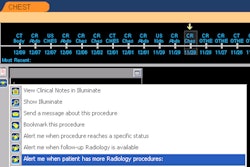LAS VEGAS - Radiology isn't the only medical specialty that produces images. In a bid to provide enterprise-wide access to all forms of medical imaging, the Cleveland Clinic has embarked on an initiative to centralize management and access to all images generated in its healthcare system.
Taking advantage of infrastructure developed for its radiology PACS, the new model will aim to store all image types on the same image repository. These studies will then be viewed on an enterprise-wide basis directly from the repository, rather than from an individual department's particular storage system. They will also be visualized in a patient-centric fashion on the electronic medical record (EMR), according to Louis Lannum, director of enterprise imaging at the Cleveland Clinic.
"We're building a repository that will allow us to visualize everything that happened to that patient," he said.
Lannum and Elena Butler, IT manager of clinical interfaces and integration, shared the Cleveland Clinic's initial experience with its new enterprise-wide image integration strategy during a Tuesday session at the Healthcare Information and Management Systems Society (HIMSS) annual meeting.
The Cleveland Clinic healthcare system comprises 12 hospitals (including one in Weston, FL), 16 family health and ambulatory surgical centers, the Las Vegas Neurological Center, and Toronto Executive Health. A hospital will also be built this year in Abu Dhabi.
Leveraging radiology
As part of a radiology road map initiative that began about six years ago, the Cleveland Clinic has replaced five RIS systems with a single RIS and also replaced an enterprise-wide PACS. A vendor-neutral archive was purchased as part of the radiology PACS replacement process and served as an extension of the department's archiving practice, Lannum said.
The institution leveraged this radiology road map to create an enterprise-wide image capturing and archiving strategy. Oversight and direction for this new strategic model was the charter of a newly created Imaging Council Group. Meeting once a month, this senior executive group has the mission of developing a shared vision across all the institutes and departments and positioning clinical imaging as a shared strategic resource, Lannum said.
"Up until recently, when you said imaging, everybody went straight to talk to radiology," he said. "Radiology from our point of view is no more than just another imaging silo. An imaging repository is a strategic resource that we are going to leverage across the entire Cleveland Clinic health system."
Under a strategy they called "No Images Left Behind," the group sought to develop a program to identify, capture, and access clinical images in all of its imaging intensive institutes and departments. Images were divided into five categories: DICOM PACS (radiology, cardiology PACS); non-DICOM PACS; standalone DICOM acquisition (such as ultrasound systems around the institution); standalone non-DICOM acquisition (cameras, endoscopy systems, etc.); and image-based reports.
A three-pronged strategy was developed, using an enterprise strategic model, a longitudinal imaging record that matches the electronic medical record, and a cloud-based storage approach, Lannum said.
"When you have an initiative like this, you're going to quickly run out of storage space," he said. "And not all of the images that you collect are clinically relevant in the time span that you have to keep them. So we're looking at using the cloud strategy."
Enterprise strategic model
The enterprise strategic model encompasses infrastructure, workflow models, an EMR integration model, and an enterprise viewer, he said.
On campus, the Cleveland Clinic's infrastructure includes a radiology PACS with local cache, an image repository with cache and a network-attached storage archive, and an image viewer embedded in the data center.
"There's 650 terabytes of spinning disk in that one data center," he said.
Local image capture stations and local image capture servers have been set up for most hospitals.
"That's the point of entry from a hospital modality to the local image manager," he said. "The local image manager feeds the radiology PACS; the PACS puts it in the repository and the enterprise viewer displays it inside the EMR."
An identical data center has been placed eight miles away, which replicates the data from the radiology PACS and the imaging repository. It's a completely redundant system, Lannum said.
"This infrastructure was built for radiology ... but other -ologies now come into that data repository," he said. "Through the same viewer, we can view all of the other images."
The institution's approach utilizes centralized storage of medical images and a single enterprise directory for all clinical images, providing access to all clinically relevant images, he said. In addition, it also provides for centralized management of imaging infrastructure, image lifecycle management, and disaster recovery/business continuity, Lannum said.
The workflow model includes an image acquisition layer, an image/data management layer, a reporting layer, a storage layer, and a visualization layer that provides for a patient-centric repository of clinical imaging data, Lannum said.
"The visualization strategy is a tight integration with this repository back to the report," he said.
A standard integration workflow model had to be defined or created for the EMR integration, Butler said. This included integrating patient demographics and utilizing an enterprise master patient index (EMPI), an orders-based workflow, and a unique accession number for each study. Studies have to be uniquely identified in the archive and all studies must be retrievable back to the source system.
"This is something that we're still working through," she said.
A study availability notification feature was also important, allowing the repository to send a notification that it has received a study and that it's ready for viewing, she said.
Along with the Cleveland Clinic's Imaging Institute, current participants in the enterprise imaging repository include the Women's Health Institute, Cole Eye Institute, and the Digestive Disease Institute, Lannum said. Approximately 20 departments in the Cleveland Clinic are currently involved at various levels.
Cloud storage
With the rapid increase in imaging volume, the institution has to reduce the storage footprint in its current data centers, he said. However, this challenge is complicated by requirements to retain images for a minimum of seven years.
Legacy exams are rarely viewed; a Cleveland Clinic study found that images acquired more than three years ago are accessed in less than 5% of cases, Lannum said. As a result, the institution is pursuing cloud-based storage to meet these long-term storage requirements.
Lannum also noted that the visualization of imaging has changed today, resulting in new visualization strategies for the Cleveland Clinic.
"If somebody is going to take a picture or an image of you, it's part of the medical decision -- it should be part of the longitudinal record and it should be accessible from the EMR," he said.



















